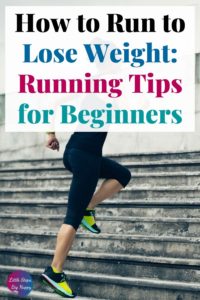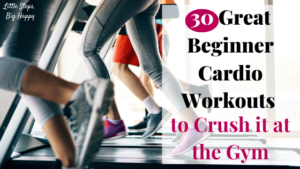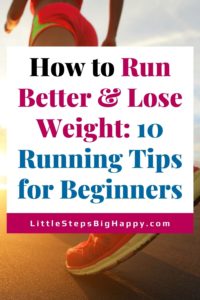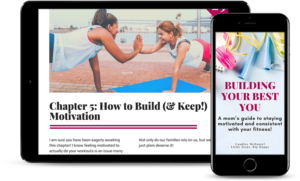If you’re looking to begin exercising to lose weight and get in shape, running is a great place to start. Before you get going, you will want to look over these running tips for beginners to lose weight, so you can start off on the right foot. 😉
Running is a great form of cardio and it’s an excellent way to exercise to supplement a healthy diet when losing weight. When getting started, it can be easy to get overwhelmed or possibly injured if you don’t know what you’re doing.
Read over these running tips for beginners so you can make sure you have all the information you need to feel comfortable and confident running.
Disclosure: This post may contain affiliate links which I’m happy to promote. All thoughts and opinions are my own. Much love & thank you for your support. 🙂 To learn more about my policy, click here.
Contents
10 Running Tips for Beginners to Lose Weight
1. Set a Goal
The very first thing you need to do when starting any new healthy habit is to set a goal. Get clear on what you want to achieve.
If you’re running for weight loss, how many pounds are you hoping to lose? How many days are you going to run?
Are you adding in other healthy habits like working on your diet, drinking water, etc? All of this is going to impact your running for weight loss plan.
If you’re new to goal setting for weight loss, here are some guidelines to follow:
- Specific – Make sure your goal has a specific target.
- Measurable – Make sure you include some type of metric to measure it by.
- Attainable – Make sure your goal is realistic.
- Relevant – Make sure your goal is in line with the overall trajectory you want for your health and fitness.
- Timely – Set a deadline for when your goal should be accomplished.
To learn more about how to set goals for your health and fitness, check out this goal-setting post here.
2. Don’t Forget to Warm Up and Cool Down
It’s important to make sure that you do a good warm-up and cool down before and after your run.
According to the Mayo Clinic, warming up your body before running helps prevent injury by loosening the joints, increasing blood flow to the muscles, and gradually increasing your heart rate and circulation.
You can warm up by taking a few minutes to stretch and then start off with a brisk walk.
Cooling down from your workout helps your heart rate and circulatory system slow down properly and come down to your normal heart rate.
Once you finish your run, slowly reduce your speed to a brisk walk and then a comfortable walk for 5-10 minutes to give your muscles and heart rate a chance to cool down.
You can also stretch for 5-10 minutes after your run to help loosen up your muscles after your workout.
3. Aim For a Steady Comfortable Pace
When you start running, unless you are training sprints, you want to start off with a nice steady pace. The goal isn’t to kill yourself with every run and hope you will lose a ton of weight.
You will see better results if you consistently incorporate running into your exercise routine. That’s a lot easier to do when you run at a steady, comfortable pace.
Run at a moderate pace that feels slightly challenging. Your breathing should be steady, but you shouldn’t feel completely out of breath or like you are struggling to breathe.
4. Wear the Right Gear
Wearing the proper clothing isn’t a requirement for running, but I can definitely tell you it makes the experience more pleasant. If you’re new to running and are struggling to keep putting one foot in front of the other, the last thing you want to deal with is shorts that are riding up and shoes that are giving you blisters.
Clothing
I definitely recommend that you wear comfortable clothes that allow your body to move when running.
You also want to take into account the fact that your body is going to be sweating and rubbing as you run. Clothing that wicks sweat away from the body and helps prevent chafing can make a huge difference in your comfort level.
Depending on the weather, you also want to consider dressing in layers. That way you don’t get cold as you’re warming up, but you can peel off the layers when you get hot.
Running Shoes
Having good running shoes is probably the most important consideration when picking running gear. Your feet are doing a lot of the work when running, and you want to give them as much support and comfort as possible.
Good running shoes will help keep your feet from rubbing or getting blisters. They will also help support your foot properly to avoid strain or injury.
A good pair of running shoes will keep you running for a lot longer.
5. Keep things interesting
Another great running tip for beginners to lose weight is to keep things interesting. There is nothing worse than getting so bored on your run you change your mind and decide to head home.
Or having nothing to distract your mind from how much farther you have to go. It can make or break your run if you have a few tricks up your sleeve to keep things interesting.
Grab some headphones
Headphones are a runner’s best friend! The easiest way to keep your run interesting is to grab some headphones and find something to listen to.
You can put on your favorite upbeat playlist or find something with a nice beat that will keep you on pace. Music with 120-140 beats per minute is considered a good running tempo.
You could also put on an audiobook or podcast. My runs have been one of my favorite ways to catch up on a good book or podcast I don’t have time to listen to/read at home.
You can find a good pair of running headphones HERE.
Get a running buddy
Another good way to keep your runs interesting is to have a running buddy. When I was training for my half marathon, I would meet a friend of mine once and week and we would run together.
We got to catch up, have some kid-free time, and the miles went by much faster than running alone.
Relevant Posts:
- 30 Great Beginner Cardio Workouts to Crush it at the Gym
- Walking Tips for Beginners: 7 Things You Need to Know
- 5 Benefits of Running Clubs for Your Health & Wellness Goals in 2023
6. Build Your distance and speed gradually
As you train regularly, you will start building up strength and endurance. This will allow you to start increasing your distance and speed in your runs.
You want to make sure that you increase your speed and distance gradually. You don’t want to overtrain your body. This could lead to injuries.
If you are running 2-4 times a week, a good rule is to increase your distance by 10% every other week. This allows your body to fully recover from the increase in distance before you add on more.
Watch your speed and pace yourself
When you are just starting out you want to focus more on using the proper technique and form rather than speed. This means you want to make sure you keep an even pace throughout your run.
Your run will go longer and smoother if you can pace yourself in the beginning and keep the pace throughout the run. You can always start out a little slower and increase your speed slightly as you go along.
Either way you don’t want to overdo it at the start and wear yourself out in the beginning of your run.
7. Fuel your body well
Hydrate, hydrate, hydrate!!
I can’t stress this one enough. Hydrate!! Make sure you drink enough water before, during, and after your run. Dehydration can occur at any time of the year, not just in the summer.
According to WebMD, here are some signs of dehydration to watch out for:
- Fatigue
- Dry eyes
- Dry mouth
- Cramps
- Headache
- Muscle spasms
Don’t overeat
It can be very easy to convince yourself that because you’re burning extra energy, you can eat extra calories. Don’t fall into this trap!
If your goal for running is to help with weight loss, then you need to make sure you don’t overeat just because you feel like you worked so hard on your run.
Try to stick to a normal healthy diet while training and you’ll see progress with your weight loss much more quickly.
Don’t worry about carb loading
Another myth when it comes to running is that you need to eat extra carbs to give you energy. Unless you’re training for a half marathon or running for more than 60 minutes, this doesn’t apply to you.
Especially as a beginner runner who is trying to lose weight, you don’t need to worry about eating extra carbs. Your body will burn the fat on your body for energy. (Which is what we’re all hoping for right?!😉)
Add in more healthy fats
If you are looking to eat more nutritious food to help fuel your body for you runs, one thing you can eat more of is healthy fats.
According to the Pennsylvania Academy of Nutrition and Dietitics, healthy fats provide energy, support cell growth, protect organs, and keep your body warm. These are all things that will help you on your run.
They recommend if you are following a 2,0000-calorie diet you should have between 400-700 calories coming from fat.
8. Be Careful Not to Overtrain
In your eagerness to be a fit running rockstar, be careful not to overtrain your body. Overtraining can lead to injury, soreness, and fatigue.
Overdoing it and having to take a break from running to recover, will hurt your progress far more than cutting back how many times you run each week. Consistency beats intensity every single time.
9. Use Good Technique
Another good running tip for beginners to lose weight is to use a good running technique. Using good running techniques will help you run more efficiently, run faster, avoid injury, and put less stress on your body.
Trust me, the sooner you learn to run with good technique the better. It’s a lot harder to fix bad technique after you’ve been doing it for a while than it is to learn it right from the beginning.
Maintain good posture
As you run, focus on the technique and posture of your upper body as well as your legs. Here is what you want your upper body to look like:
- Shoulders down and back
- Chin up and eyes looking ahead
- Back straight
- Core engaged – pull your belly button in toward your spine
- Arms swing forward as you run
- Hands held in a loose fist
Take short easy steps
Another area of your form to focus on is your legs and feet. When you are running for distance (i.e. not sprinting) you want to make sure you take short quick strides.
Your foot should land underneath you with each step, and the majority of your forward distance will come from pushing off your back foot.
Your foot should strike the ground around midfoot and then you roll forward so you are pushing off the ball of your foot with each step forward. Each step should be quiet and help you spring forward.
Using this technique is a lot easier on your body and your joints as you run.

10. Keep Variety in Your Workouts
Variety is the spice of life and that absolutely applies to running for weight loss. By adding variety to your runs and your other workouts you will keep things interesting, prevent injury, and get faster results with your weight loss.
Alternate strength training days with running days
A great way to get variety in your workouts is to you make sure you include strength training in between your running days. Strength training is crucial for runners.
It helps increase your endurance and run speed. Strength training also helps ensure overall muscle balance and prevents injury.
Running is a full-body workout, and that body is going to perform better if you help strengthen and tone it outside of just running.
Try intervals
The last item on this list of running tips for beginners to lose weight is to try intervals. Intervals are a great way to increase your speed and keep your workouts interesting.
One method of intervals is to run at a comfortable pace for 1-2 minutes, then increase your speed for a short burst of 30 seconds to 1 minute.
You repeat the pattern of 1-2 minutes at a comfortable pace with a 30-second to 1-minute increase for the duration of your run.
You can also use this method to work up to running in the beginning. When I first started running for weight loss, I couldn’t run for anything longer than a few minutes without needing to stop and catch my breath.
So I started off doing walk/jog intervals. As I increased my endurance, I was able to run for longer and longer distances.
Before I knew it, I was running for 30 minutes straight.

FAQ’s About Running Tips For Beginners to Lose Weight
Having gone through my own weight loss journey, including learning to become a runner, I imagine you still have a few questions. I sure did!
Here are a few common questions people have when researching running tips for beginners to lose weight. I’ll share what I’ve learned from my own weight loss and running experience.
Can I lose weight just by running?
Short answer: No. You can’t lose weight by performing any type of exercise without making some sort of change to your diet.
In my experience, successful, sustainable weight loss is about 80% diet and 20% exercise.
Now, that being said, running does burn a ton of calories. If you’ve only got a short amount of time to work out and you want the best bang for your buck, running is a good choice.
Combined with some healthy eating habits, running was a great addition to helping me lose weight.

How much should I run per day to lose weight?
If you’re new to running, I would actually suggest you run 2-4 days a week instead of every day. As a beginner, your body needs to develop the muscle and stamina to be able to run every day.
Running too often before you’re ready is a good way to injure yourself or burn out really fast. I understand how eager you are to see progress with your weight loss. I felt the same way!
But you’re much better off starting a running plan that allows your body enough rest time to recover. If you injure yourself from overtraining, you’ll slow down your progress even more than you would just starting off a little slower.
With that being said, Jason Fitzgerald, a USATF-certified running coach, recommends running 2-4 days a week for 20-30 minutes. You can always increase your time as you get stronger.
Can I lose weight by running 30 minutes per day?
Only if you pay attention to your diet as well. Running 30 minutes a day will burn a lot of calories, but if you overeat as soon as you get home, it doesn’t matter.
It’s ridiculously easy to eat more calories than you burn. Even if you are running for 30 minutes a day.
According to a study done in 2011, a 160 lb person will burn on average 303 calories if they ran for 30 minutes. That’s 1 slice of pizza. Just 1!
So if you run for 30 minutes every day, but you still treat yourself to an extra donut, piece of pizza, or cookie, you’ll negate all your hard work.
Use running as a complement to a healthy diet and you’ll see the weight loss progress that you want.
Running for Weight Loss Plan
Now that you’ve got some great running tips for beginners to lose weight, you need a good running plan. Here are 3 great beginner running plans to get you started:
- How to Start Running Today: A Beginners Guide
- 8 Week Beginner’s Walk-To-Run Program
- The 8-Week Beginner Running Plan
And remember, these programs are great guidelines, but always listen to your body. It’s better you take things at your own pace than overtraining and injuring yourself.
Running Tips for Beginners to Lose Weight Conclusion
So those are my 10 running tips for beginners to lose weight. Now that we have covered running gear, form, and general good practices, you have all the information you need to get out there and own your next run!
I would love to know which running tips for beginners to lose weight you found most helpful, or even share your own tips. Comment below or email me at Candice@littlestepsbighappy.com. Follow me on Pinterest for more beginner fitness and weight loss tips.
Want more fitness tips for moms?
- 5 Powerful Reasons Exercise is Important for Moms
- How to Avoid Mom Guilt Over Exercising: 10 Quick Tips
- How to Find Time to Workout as a Busy Mom: 11 Tried & True Tips
- 7 Quick Workout Ideas for Busy Moms on the Go
- 7 Ways to Get a Quick Workout at Home
- 3 Reasons You Don’t Exercise Regularly and How to Start
- 6 Easy Tips to Help You Crush Your Exercise Goals
- Walking Tips for Beginners: 7 Things You Need to Know
- 7 Easy Ways Moms Can Live a Fitness Lifestyle
- 10 Tips for Hiring a Personal Trainer You’ll Love
- Quick & Helpful Tips for Setting up a Home Gym
- 5 Benefits of Running Clubs for Your Health & Wellness Goals in 2023
Pin this for later!

You might also like:




I’m a busy mom of 3 turned Health and Fitness Coach and Self Defense Instructor. I help inspire other moms to reach their health, fitness, and weight loss goals. You can usually find me chasing my kiddos around, training Brazilian Jiu-Jitsu, or sneaking away to read romance novels. About Me



